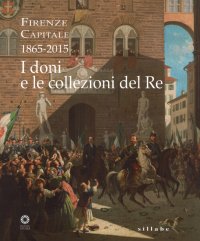De Nittis e la rivoluzione dello sguardo.
Ferrara, Palazzo dei Diamanti, December 1, 2019 - April 13, 2020.
Edited by Pacelli M. L., Guidi B. and Pinet Hélène.
Translation by Archer M.
Ferrara, 2019; bound, pp. 288, col. ill., cm 24x29.
cover price: € 48.00
|
Books included in the offer:
De Nittis e la rivoluzione dello sguardo.
Ferrara, Palazzo dei Diamanti, December 1, 2019 - April 13, 2020.
Edited by Pacelli M. L., Guidi B. and Pinet Hélène.
Translation by Archer M.
Ferrara, 2019; bound, pp. 288, col. ill., cm 24x29.
FREE (cover price: € 48.00)
De Nittis. Peppino e il ventaglio magico
Roma, chiostro del Bramante, November 13, 2004 - February 27, 2005.
Milano, Fondazione Antonio Mazzotta, primavera 2005.
Milano, 2005; bound, pp. 100, ill., cm 16x22.
(Ragazzi).
FREE (cover price: € 14.00)
Donna. Immagini del femminile da Boldini a oggi
Pescara, Museo d'Arte Moderna Vittoria Colonna, October 20, 2005 - January 23, 2006.
Milano, 2005; paperback, pp. 120, ill., cm 23x27.
(Biblioteca d'Arte).
FREE (cover price: € 28.00)
Firenze capitale (1865-2015). I doni e le collezioni del Re
Firenze, Galleria d'Arte Moderna - Appartamento della Duchessa d' Aosta, November 19, 2015 - April 3, 2016.
Edited by Condemi S.
Livorno, 2015; paperback, pp. 351, b/w and col. ill., b/w and col. plates, cm 24,5x28,5.
FREE (cover price: € 30.00)
In the Desert Margins the Settlement Process in an Ancient South and East Arabia
Michel Mouton - Schiettecatte Jeremie
Libreria Editrice L'Erma di Bretschneider
English Text.
Roma, 2014; paperback, pp. 336, col. ill., cm 24x28.
(Arabia Antica. Archaeological and Philological Series. 9).
series: Arabia Antica. Archaeological and Philological Series
ISBN: 88-913-0680-0 - EAN13: 9788891306807
Subject: Essays (Art or Architecture)
Languages: 
Weight: 1.8 kg
Evolution was endogenous, far from the main corridors of migrations and invasions. Influences from the periphery did not cause any prominent change in the remarkably stable communities of inner Arabia in antiquity. The settlement process and the way of life was primarily dictated by access to water sources and to the elaboration of ever-spreading irrigation systems.
Beyond common traits, two models characterise the ancient settlement pattern on the arid margins of eastern and southern Arabia. In South Arabia, the settlement model for the lowland valleys and highland plateaus results from a long-term evolution of communities whose territorial roots go back to the Bronze Age. It grew out of major communal works to harness water. Into a territory of irrigated farmland, the south- Arabian town appeared as a central place. Settlements constituted networks spread across the valleys and the plateaus. Each network was dominated by a main town, the centre of a sedentary tribe, the capital of a kingdom.
In East Arabia, the settlement pattern followed a different model which emerged in the last centuries BC along the routes crossing the empty spaces of the steppe, in a nomadic environment. Each community spread over no more than one, two or three settlements. These settlements never grew very large and the region was not urbanised to the same degree as in the southwest of the Arabian Peninsula. Permanent settlements were places for exchanges and meetings, for craft productions, for worship, where the political elites resided, where the wealth from long-distance trading was gathered, and where surplus from the regional economy was held. Each town was isolated, like an island in an empty space.












